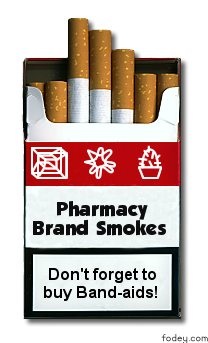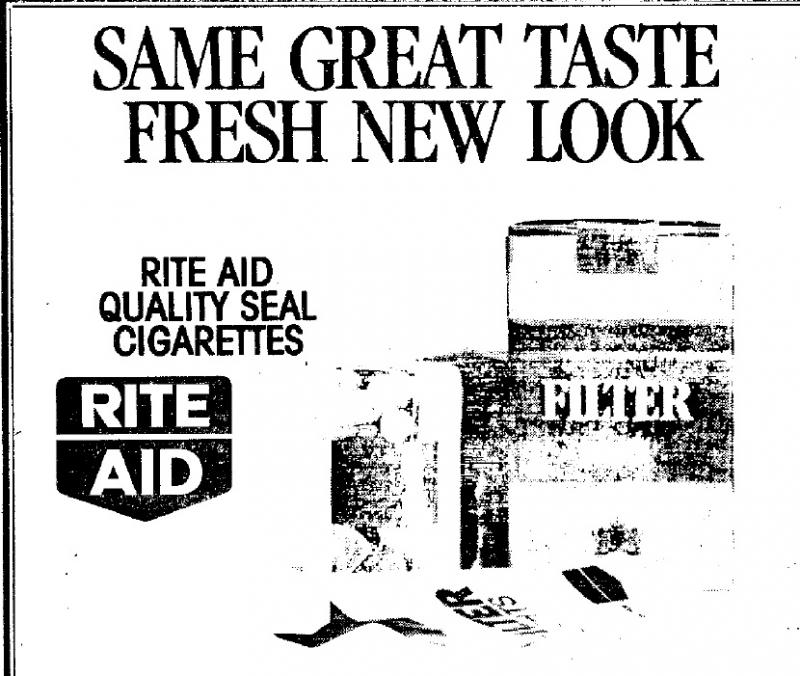Submitted by Anne Landman on
 On October 1, 2008, the city of San Francisco put a law into effect that prohibits the sale of cigarettes in pharmacies. Walgreens drug store chain and Altria/Philip Morris have filed lawsuits against the city over the measure. In a September 30, 2008 statement about the new law, San Francisco Mayor Gavin Newsom related the city's simple rationale: "Pharmacies should be places where people go to get better, not where people go to get cancer."
On October 1, 2008, the city of San Francisco put a law into effect that prohibits the sale of cigarettes in pharmacies. Walgreens drug store chain and Altria/Philip Morris have filed lawsuits against the city over the measure. In a September 30, 2008 statement about the new law, San Francisco Mayor Gavin Newsom related the city's simple rationale: "Pharmacies should be places where people go to get better, not where people go to get cancer."
Familiar corner drug store chains like Rite Aid and Walgreens have long cultivated an image of being all about health. Their web sites feature photos of friendly-looking pharmacists in white coats ready to help us with our health care needs. The Rite Aid company Web site tells us they are "committed to the healthcare needs of our customers." CVS says its vision is to "strive to improve the quality of human life" by making "high-quality health and pharmacy services safe" and easy to access. Walgreens says it stands ready to help people by supplying "health and wellness products" and health information. If all this makes you feel that these drugstore chains have your best interests at heart, it's certainly by design. But don't be taken in too easily.
Pharmacies trade on their image of being trustworthy and concerned about peoples' health. They are among people's most respected sources of health care information, right after doctors and nurses. Given all this, isn't it odd that pharmacies continue to sell cigarettes, long recognized as one of the most common causes of heart disease and fatal cancers in the world today? Cigarettes have resided on pharmacy shelves for decades, to the point that most people pay little or no attention to them. But when you start to consider this issue, there is clearly something incongruous about selling cigarettes alongside asthma inhalers, cough remedies and prescription medications. The very presence of cigarette displays in drug stores sends a disingenuous message, particularly to kids, about the health hazards of cigarettes. Selling cigarettes in retail outlets devoted to improving human health is a subtle but powerful way to preserve the social acceptability of smoking. The profits that drug store chains derive from cigarette sales helps the industry maintain influence over large corporate drug chains, who have in the past served cigarette makers well as allies for their issues.
Tobacco Companies and Drug Stores: A Long and Close Partnership
 It isn't immediately obvious to the general public, but drug stores and tobacco companies have a long history of helping advance each others' interests.
It isn't immediately obvious to the general public, but drug stores and tobacco companies have a long history of helping advance each others' interests.
In the 1970s, the Tobacco Institute (TI) engaged drug stores to help defend cigarette makers in the "smoking and health controversy." A decade after the landmark 1964 Surgeon General's report officially declared smoking a known cause of cancer and other serious diseases, public concern started growing about the health effects of secondhand tobacco smoke on nonsmokers. A confidential 1977 memo to William Kloepfer of the Tobacco Institute from Institute president Horace R. Kornegay discusses the possibility of enlisting the Walgreens Drugstore chain to help the Institute promote disinformation about the link between secondhand smoke and disease:
Curtis Judge...told me about [a] meeting with David C. Carlson, manager of News and Information Services for Walgreen Drugs. ... Carlson expressed interest in being of assistance to the tobacco industry in getting the true word put about ... Curt suggested that I call Mr. Carlson which I have done. He indicated a real interest in being of every possible assistance to us ... I further told him that I would call him in about two weeks and that we would agree upon a mutually convenient time and place to meet and discuss what and how he and his company could be of help.
The Tobacco Institute pursued their plan, sending a letter to Walgreens describing how another market chain had helped TI by distributing a pamphlet called "Smoker or Nonsmoker" that reassured the public that there was no link at all between secondhand smoke and illness. The Institute proposed Walgreens do the same, at TI expense. The pamphlet, produced by the TI, reassured the public that "growing scientific research provides strong evidence that tobacco smoke does not affect nonsmokers' health."
Walgreens was eager to help the Institute, and even proposed using their position as a "health center" to benefit the tobacco industry in such a campaign. A Walgreens representative wrote back to the Institute saying,
Thank you, Mr. Kornegay, for taking time from your busy schedule to chat with me about the tobacco industry...We are exploring the possibilities of an information program which will help both the tobacco industry and ourselves... [a]s an established "health center", there are many, many things we can do to "gain and maintain the understanding and support of the public."
Pharmacies Promoting Cigarettes?
 As recently as 1988, Rite Aid sold its own in-house brand of cigarettes called "Rite Aid Quality Seal Cigarettes". The packs were advertised alongside the logo of the pharmacy chain, sending the public a mixed message about the harm the product causes.
As recently as 1988, Rite Aid sold its own in-house brand of cigarettes called "Rite Aid Quality Seal Cigarettes". The packs were advertised alongside the logo of the pharmacy chain, sending the public a mixed message about the harm the product causes.
More recently, in 2006 Rite Aid entered into a joint health promotion with the American Heart Association called "Go Red For Women," in which Rite Aid claimed it was "taking a stand against heart disease in women." Rite Aid placed large red posters touting its "healthy heart" campaign in the windows of its stores, often immediately adjacent to its cigarette displays, thus allowing Rite Aid to promote both cigarettes and a professed concern for their customers' cardiac health simultaneously.
Rite Aid not only knew well that cigarettes cause heart disease in both men and women, but took steps to assure it would be inoculated against any legal claims arising from that fact. Brown & Williamson signed an indemnification contract holding Rite Aid harmless against legal action taken for damages, illness, or personal injury arising from selling cigarettes, and promising to pay for Rite Aid's defense in court if they should be sued for selling cigarettes. In 1993, Walgreens sought the same legal protections from Philip Morris. I found a similar indemnification contract dated 1993 in Philip Morris' "Walgreens" file, making it clear that Walgreens, too, knew that cigarettes were hazardous to their customers. Yet they continued to sell them.
Organized Action Against Cigarette Sales in Pharmacies
In the early 1990s, the California Medical Association (CMA) and California Pharmacists Association began questioning the propriety of pharmacies selling cigarettes. In 1995 the CMA Foundation began a project called the Pharmacy Partnership, a coalition of pharmacists, physicians, public health agencies and community leaders, who started urging independent pharmacies to stop selling tobacco in their stores. In 1998 the Partnership initiated a photojournalism project to document the placement of cigarettes within easy reach of children in pharmacies. The Partnership's Web page in June, 1998, read
There is a place where new dolls smile amidst cartons of Salem Lights, toy cars shine invitingly alongside Marlboro signs, and the Easter Bunny sits happily atop a case of pipe tobacco...Children in this drugstore can't reach high enough for the Hot Wheels and toy fire trucks, but can easily grasp Marlboro cigarettes.
Photographs taken for the project captured tobacco products displayed next to child-friendly items like Disney videos, electronic toys, stuffed animals, gum balls and Cracker Jacks. In 2000, the Pharmacy Partnership started compiling and posting a list of pharmacies that refused to sell tobacco products. It posted the list on three different Web sites, along with surveys showing a majority of Californians believed that it was wrong for pharmacies to sell cigarettes.
Thirteen years of this campaign in California increased awareness of the issue, resulting in growing pressure to end the practice of selling cigarettes in pharmacies. San Francisco's new law grew out of this public education effort. Plenty of people probably think that San Francisco is just a weird place and such a freakish law could never get enacted elsewhere. "This isn't California," they'll say of their home state, "and people just won't buy it."
But as a friend of mine who lives in California once said about the state's seemingly impossible-to-achieve 1998 law ending smoking in bars, a feat now being repeated in jurisdictions all across the U.S. and in many countries around the world, "Everyplace is California. It's just a matter of time."

Comments
Mutternich replied on Permalink
It's not hard to see
Rik Masterson replied on Permalink
Prescription drugs 4th leading killer in the U.S.
Anne Landman replied on Permalink
Not a valid comparison